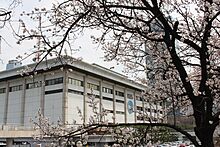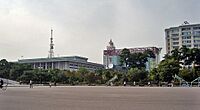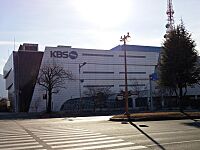Korean Broadcasting System facts for kids
 |
|

Main building of the Korean Broadcasting System
|
|
|
Native name
|
|
|---|---|
| Hangul | |
| Hanja | |
| Revised Romanization | Han-guk Bangsong Gongsa |
| McCune–Reischauer | Han'guk Pangsong Kongsa |
| Statutory corporation | |
| Industry | Public Broadcasting |
| Predecessors |
|
| Founded |
|
| Founder | Governor-General of Korea |
| Headquarters |
Yeouido, Yeongdeungpo-gu, Seoul
,
South Korea
|
|
Area served
|
Worldwide |
|
Key people
|
Park Min (President and CEO) |
| Products | |
| Owner | Government of South Korea |
|
Number of employees
|
4,701 (As of 1 June 2020) |
| Subsidiaries |
|
The Korean Broadcasting System (KBS; Hangul: 한국방송공사; Hanja: 韓國放送公社; RR: Han-guk Bangsong Gongsa; MR: Han’guk Pangsong Kongsa) is the national broadcaster of South Korea. Founded in 1927, it is one of the leading South Korean television and radio broadcasters.
The KBS operates seven radio networks, ten television channels and multiple Internet-exclusive services. Its flagship terrestrial television station KBS1 broadcasts on channel 9, while KBS1 sister channel KBS2, an entertainment oriented network, broadcasts on channel 7. KBS also operates the international service KBS World, which provides television, radio and online services in twelve different languages.
Contents
History
Early radio broadcasts
The KBS began as Gyeongseong Broadcasting Station (Hangul: 경성방송국; Hanja: 京城放送局) with call sign JODK, established by the Governor-General of Korea on 16 February 1927. It became the Chōsen Broadcasting Corporation (Japanese: 朝鮮放送協會, Hepburn: Chōsen Hōsō Kyōkai) in 1932. After Korea was liberated from Japanese rule at the end of World War II, this second radio station started using the call sign HLKA in 1947 after the US-occupied Korea was granted the ITU prefix HL. After doing a national broadcast, the radio was renamed Seoul Central Broadcasting Station in 1948.
1950s–1960s – Move into television
Television broadcasts in South Korea began on 12 May 1956 with the first television station HLKZ-TV. After financial difficulties, it was acquired by KBS in 1961.
1970s – Expansion
KBS station status changed from government to broadcasting station on 3 March 1973. Construction of KBS headquarters in Yeouido started in 1976. In 1979 KBS radio began broadcasting on the FM band with the launch of KBS Stereo (now KBS 1FM). Colour television began that year.
1980s – Advertising started after controversial merger
KBS began accepting advertising in 1980, differing from the norm of advert-free broadcasting by public broadcasters, after the forced merger of several private broadcasters into KBS by the military government of Chun Doo-hwan (see Controversies).
1990s – Spinoff of EBS
In 1981, KBS launched KBS 3TV and Educational FM and on 27 December 1990, the channels split from KBS to form the Educational Broadcasting System (EBS).
After a revision of the television licensing fee system in 1994, 1TV and Radio1 stopped broadcasting commercials.
2010s
After first broadcasting HD programmes in 2001, KBS completely transferred to digital broadcasting in 2012.
On 3 March 2013, computer shutdowns hit South Korean television stations including the KBS. The South Korean government asserted a North Korean link in the March cyberattacks, which has been denied by Pyongyang.
In 2013, KBS World Radio commemorated its 60th anniversary, and KBS World TV celebrated 10 years of its foundation.
In 2014, KBS World 24 was launched, mainly for Koreans abroad.
In 2015, KBS was honored to have its archives of the KBS Special Live Broadcast, Finding Dispersed Families, inscribed on the UNESCO Memory of the World Register. This makes KBS only the world's second broadcaster to have a broadcast programme on the prestigious list.
The KBS network is dedicated to deliver the exclusive Special Live Broadcast, Finding Dispersed Families, via its primary channel, KBS1. KBS News served as the program's producer. The program made its premiere telecast on 10:15 pm KST on 30 June 1983. After more than 6 months, the special live programme ended at 4 am on 14 November 1983. This marks a total duration of 453 hours and 45 minutes of live broadcast over the period of 138 days, aired nationwide on KBS1. The whole live broadcast was recorded. The KBS's archives of Special Live Broadcast, Finding Dispersed Families include; 463 videotapes of the original recordings, and many kinds of associated materials, generated in the course of the extraordinary broadcast, such as the posters carrying the participating dispersed family members' capsule stories, cue sheets, programming schedules, radio recording materials, and related photographs. A total of 20,522 such assorted materials have been preserved in the archives. The program was the biggest public affairs program ever produced by KBS in the decade and was the first to tackle the issue of families separated because of the long Korean War (1950–1953), which garnered even international coverage.
In 2017, KBS launched the world's first terrestrial UHD broadcasting service.
In June 2018, KBS led the operation of the IBC (International Broadcasting Centre) inside the KINTEX (Korea International Exhibition Center), located in Goyang City, as Host Broadcaster for the April 2018 inter-Korean summit. During the summit, KBS successfully delivered all the moments associated with the historic summit for more than 3,000 local and overseas media representatives, gathered at the IBC. Throughout the day of the summit, KBS delivered live coverage and the latest developments of the event through its continuous special news bulletins. Also, its prime-time news programmes, KBS News 9 and KBS Newsline provided audiences with highlights and implications of the historic summit through comprehensive and analytical reports. Also, KBS World TV delivered Live Coverage of April 2018 Inter-Korean summit with English subtitles for its audiences across 117 countries worldwide.
In May 2019, as the public service broadcaster in South Korea, KBS undertook a major reform in its Disaster Broadcast System in order to provide exclusive emergency services for people in the country in times of emergency. To be headed by President and CEO of KBS, the renewed system will allow the use of maximum resources of the organization under emergency circumstances. Under the reform, KBS will focus on; swift and efficient emergency broadcast and coverage; to deliver essential information in innovative ways with the ultimate aim to minimise losses and damages; to strengthen its digital platforms to better serve wide-ranging audience groups. In particular, KBS signed contracts with nine sign language interpreters in an effort to enhance broadcast services for audiences with disabilities. In addition, KBS is committed to improve its English subtitle services for people from overseas.
Structure
KBS is a public corporation (Hangul: 공사; Hanja: 公社) funded by the South Korean government and license fees, but is managed independently. As part of the Constitution, the president of KBS is chosen by the President of South Korea, after being recommended by its board of directors. Political parties in South Korea also have the right to name members of the KBS board of directors.
Because of this system, which gives politicians effective control over choosing the president of KBS, as well as its board of directors, people who are critical of the system cite political intervention in KBS's governance as reason for revising the current system of recruiting.
In order to uphold and defend independence, KBS, since 2018, created a 'Public Advisory Group', as part of the selection process of new KBS President and CEO. The new President and CEO of KBS is recommended by the KBS Board of Governors, once the selection process by the Group is completed. The Group examines Presidential candidates in the form of a presentation, a panel discussion, and an interview. The new President and CEO of KBS will finally be appointed by the President of Republic of Korea, after going through the mandatory parliamentary audit by the National Assembly.
Around 49% of KBS's revenue comes from a mandatory television licence fee of 2,500 won, with another 18.7% coming from commercial advertisement sales.
In addition to 18 regional stations and 12 overseas branches, there are eight subsidiary companies such as KBSN, KBS Business and KBS Media, which manage KBS content.
CEOs
| Generation | Name | Start | Retirement | Note |
|---|---|---|---|---|
| 1 | Hong Kyung-mo | February 1973 | February 1979 | N/A |
| 2 | ||||
| 3 | Choi Se-kyung | February 1979 | July 1980 | |
| 4 | Lee Won-hong | July 1980 | February 1985 | |
| 5 | ||||
| 6 | Park Hyun-tae | February 1985 | August 1986 | |
| 7 | Jung Koo-ho | August 1986 | November 1988 | |
| 8 | Seo Young-hoon | November 1988 | March 1990 | |
| 9 | Seo Ki-won | April 1990 | March 1993 | |
| 10 | Hong Doo-pyo | March 1993 | April 1998 | |
| 11 | ||||
| 12 | Park Kwon-sang | 20 April 1998 | 10 March 2003 | |
| 13 | ||||
| 14 | Seo Dong-koo | 22 March 2003 | 2 April 2003 | |
| 15 | Jung Yeon-joo | 28 April 2003 | 11 August 2008 | Dismissed |
| 16 | ||||
| 17 | ||||
| 18 | Lee Byung-soon | 28 August 2008 | 23 November 2009 | N/A |
| 19 | Kim In-kyoo | 24 November 2009 | 23 November 2012 | |
| 20 | Kil Hwan-young | 23 November 2012 | 10 June 2014 | Dismissed after strike |
| 21 | Jo Dae-hyun | 28 July 2014 | 23 November 2015 | N/A |
| 22 | Ko Dae-young | 24 November 2015 | 23 January 2018 | Dismissed after strike |
| 23 | Yang Seung-dong | 9 April 2018 | 23 November 2018 | N/A |
| 24 | 24 November 2018 | 9 December 2021 | ||
| 25 | Kim Eui-chul | 10 December 2021 | 12 September 2023 | Dismissed |
| 26 | Park Min (journalist) | 12 November 2023 | present |
Channels
Terrestrial television
| Name | Logo | Description |
|---|---|---|
| KBS1 | KBS's flagship channel, it broadcasts news and current affairs, education, drama, sports, children's programming and culture. It launched in 1961 as HLKA-TV and is solely funded by the license fee, airing commercial-free. It is available nationally on channel 9, broadcasting via digital terrestrial television. KBS1 also airs public information films and minor entertainment programming, the majority of which is on KBS2. | |
| KBS2 | KBS's entertainment channel, it was launched in 1980 as a replacement for the Tongyang Broadcasting Corporation, which was controversially merged with KBS. It is available on digital channel 7 via digital terrestrial television. KBS2 also airs live sports coverage, children's programming, public information films and less news, current affairs and drama programming, the majority of which is on KBS1. | |
| KBS NEWS D | 24-hour news and weather channel, started as an online news channel, KBS 24 News. unlike the other two channels, it is also shown freely in the KBS News YouTube channel | |
| KBS UHD | the Ultra High-Definition channel, using the ATSC 3.0 format. The channel airs music videos, plus re-runs of TV series and various programming. |
While KBS1 and KBS2 phased out analogue services on 31 December 2012 as part of the switchover to digital television in South Korea, it would appear that KBS1 and KBS2 is still unofficially broadcast in analog via UHF, presumably nearby the DMZ, albeit using the SECAM D/K standard.
Cable and satellite television
- KBS Life – A culture and drama channel, launched in 1995 as KBS Satellite 2. It was renamed as KBS Korea in 2002, renamed as KBS Prime in 2006, renamed as KBS N Life in 2015 before becoming KBS Life.
- KBS Drama – formerly KBS Sky Drama, launched in 2002
- KBS N Sports – formerly KBS Sports/KBS Sky Sports, launched in 2002
- KBS Joy – a comedy and quiz show channel that was launched in 2006
- KBS Kids – the children's channel, launched in 2012
- KBS Story – a channel aimed at a female audience, launched in 2021
These six channels are carried by cable and satellite operators in South Korea. There are 100+ cable operators in South Korea, and Skylife is the sole satellite television service provider. These channels are managed and operated by KBS N, a subsidiary company of KBS.
KBS World
KBS World is the international television and radio service of KBS. It was officially launched on 1 July 2003. It is broadcast on a 24-hour schedule with programs including news, sports, television dramas, entertainment, and children's. KBS World television is broadcast locally and around the world. As of July 2007, around 65% of its programs are broadcast with English subtitles, it is available in 32 countries, and reportedly more than 40 million households around the world can access KBS World. It has two overseas subsidiaries: KBS America and KBS Japan. KBS Japan is independently operated by a KBS subsidiary in Japan, and most programs are provided with Japanese subtitles.
KBS World Television is a television channel that mainly broadcasts programs commissioned for KBS's 2 terrestrial networks: KBS1 and KBS2. KBS World television is distributed over several international communication and broadcasting satellites such as IS-19, IS-20, IS-21, Measat 3, Apstar 6 & 7, Eutelsat Hotbird 13A, Galaxy 11, 18 & 23, Badr 6, Vinasat 1, Palapa D, SES 7, Telkom 1, Thaicom 5, EchoStar 15, Anik F3. Local cable and/or satellite operators receive the signal from one of these satellite and carry the signal to end subscribers of their own networks. KBS doesn't allow individual viewers to receive the signal from IS-19, IS-20, IS-21, Measat 3, Asiasat 5, and Galaxy 18. The signal from Badr 6 and Eutelsat Hotbird 13A is Free-to-Air.
KBS World TV commenced its service via YouTube in 2007. Its YouTube subscriber count reached 10 million in May 2019 and recorded 13.5 million in July 2020. KBS World TV is also available on various social media platforms such as Facebook, Twitter, Instagram, and LINE. Its social media surpassed 20 million subscribers in April 2020.
KBS Korea (previously KBS World 24), a spin-off channel of KBS World, is targeting at Koreans living overseas.
Radio
- KBS Radio 1 (711 kHz AM/97.3 MHz FM KBS Radio Seoul) – News, current affairs, drama, documentary, and culture. Launched in 1927 as Gyeongseong Broadcasting Corporation JODK, it became HLKA in 1947 and it became KBS Radio 1 in 1981.
- KBS Radio 2 (603 kHz AM/106.1 MHz FM KBS Happy FM) – Popular music. Launched in 1948 as HLSA.
- KBS Radio 3 (1134 kHz AM/104.9 MHz FM KBS Voice of Love FM) – Launched in 1980 and ceased broadcasting in 1981. It was later replaced by KBS Radio 2's regional radio service and Educational FM (now EBS FM). Later re-launched in 2000 as a spin-off from KBS Radio 2. For the first time in 2010, it was launched on FM and restructured as a radio station for the disabled.
- KBS 1FM (93.1 MHz Classic FM) – classical music and folk music. Launched in 1979 as KBS Stereo, adopted current name in 1980.
- KBS 2FM (89.1 MHz/DMB CH 12B Cool FM) – entertainment and news. Launched in 1966 as Radio Seoul Broadcasting (RSB), renamed as TBC-FM in the 1970s, renamed as KBS Radio 4 in 1980 after TBC-FM forced merger to KBS, then adopted current name in 2003.
- KBS Hanminjok Radio (literal meaning: KBS Korean Nationality Radio) (6.015 MHz shortwave and 1170 kHz mediumwave) – launched in 1975 as KBS Third Programme
- KBS World Radio – the South Korean international radio service, funded directly by the government.
Branding logo
Programmes
Foreign partners
Americas
| Country | Public television |
|---|---|
| Argentina | Radio y Televisión Argentina |
| Bolivia | Bolivia TV |
| Brazil | Empresa Brasil de Comunicação |
| Canada | Canadian Broadcasting Corporation |
| Chile | Televisión Nacional de Chile |
| Colombia | RTVC Sistema de Medios Públicos |
| Costa Rica | Trece Costa Rica Televisión |
| Cuba | Cuban Institute of Radio and Television |
| Dominican Republic | Corporación Estatal de Radio y Televisión |
| Ecuador | Medios Públicos EP |
| El Salvador | TVES (El Salvador) |
| Honduras | Televisión Nacional de Honduras |
| Mexico | Sistema Público de Radiodifusión del Estado Mexicano |
| Nicaragua | Sistema Nacional de Televisión |
| Paraguay | Paraguay TV |
| Peru | Instituto Nacional de Radio y Televisión del Perú |
| United States | American Broadcasting Company, PBS |
| Uruguay | Televisión Nacional Uruguay and TV Ciudad |
| Venezuela | Bolivarian Communication and Information System |
Europe
| Country | Public television |
|---|---|
| Belgium | Vlaamse Radio- en Televisieomroeporganisatie |
| Finland | Yle |
| France | France Televisions |
| Germany | ARD |
| Italy | Radiotelevisione Italiana |
| Netherlands | Nederlandse Publieke Omroep |
| Norway | Norsk Rikskringkasting |
| Poland | Telewizja Polska |
| Portugal | Rádio e Televisão de Portugal |
| Russia | VGTRK |
| Spain | Televisión Española |
| Sweden | Sveriges Television |
| Turkey | Turkish Radio and Television Corporation |
| Ukraine | Suspilne Movlennia |
| United Kingdom | BBC |
Asia
| Country | Public television |
|---|---|
| Cambodia | National Television of Kampuchea |
| China | China Central Television |
| Hong Kong | RTHK |
| India | Doordarshan |
| Indonesia | RRI and TVRI |
| Japan | Nippon Hōsō Kyōkai |
| Malaysia | Radio Televisyen Malaysia |
| Mongolia | Mongolian National Broadcaster |
| Philippines | Presidential Communications Office |
| Thailand | Thai PBS |
| Taiwan | Public Television Service |
| Vietnam | VTV |
Oceania
| Country | Public television |
|---|---|
| Australia | Australian Broadcasting Corporation, Special Broadcasting Service |
| New Zealand | Television New Zealand |
Operational status
Headquarters
KBS carried out a large-scale organizational reform on 1 March 2019. The focus of the reform is to; further strengthen the KBS's capabilities of content creation; enhance the organization's digital work flow; and improve audience services. As part of the new strategy, KBS created Content Production 2 Division, a new integral body, responsible for a highly efficient operation of production, marketing, as well as content businesses. The new division ultimately aims to bring outstanding dramas and entertainment programming by boosting creative nature of the production function, and minimizing its decision-making process.
The new reform strategy introduced Public Service Media Strategy team under Strategy and Planning Division. Public Service Media Strategy is mainly responsible for developing KBS's digital strategies for different audiences to enjoy KBS content via assorted digital media platforms. The reform brought changes in Programming Division as Digital Media department has further expanded its roles under the division. Digital News department attached to News and Sports Division has also strengthened its functions in line with the recent reform initiative. Another significant change in the reform is that new 'Audience Relations Center' has become an executive department, to be operated directly by KBS President and CEO. The Audience Relations Center will dedicate its resources to further enhance audience services, and create more opportunities for audiences to take part in various initiatives developed by KBS. And Local Stations Management has been reorganized to be supervised under KBS Executive Vice President, as KBS has a plan to build a regional broadcasting system in response to a growing demand for greater regional autonomy.
See also
 In Spanish: Korean Broadcasting System para niños
In Spanish: Korean Broadcasting System para niños
- Educational Broadcasting System
- KBS World Radio
- KBS America
- KBS World Canada
- KBS Symphony Orchestra
- KBS Hall
- Television in South Korea
- Korean Central Television (equivalent in North Korea)








